Lombok conservation project aims to boost sea turtle survival rate 50-70%
As two-foot waves roll onto the sandy shoreline on quiet Landang Luar Beach in Lombok, Indonesia, I’m one of a dozen westerners huddling close to the water’s edge. It’s just before dusk. We’re not watching a floating clump of tourist surfers or wondering if nearby local fishermen, standing calf-deep in the shallows, will make a catch.
Instead, we’re entranced with what’s at our feet: tiny sea turtles, most about 10 cm (four inches) long and roughly three months old. By that age, they’ve built up strength after being fed and cared for in some of the 30 open-air water tanks operated by Green Lion Indonesia, says Andre Andrianto, sea turtle conservation program co-coordinator. This group is part of a Thailand-based, global community of “pioneers in impactful tourism.”
Several dozen of these endearing creatures are crawling slowly towards the Bali Sea, part of the Indian Ocean on this scenic island east of Bali. Their flippers, small but strong, leave long, patterned trails in the sand like impromptu art from mini-tire tracks.

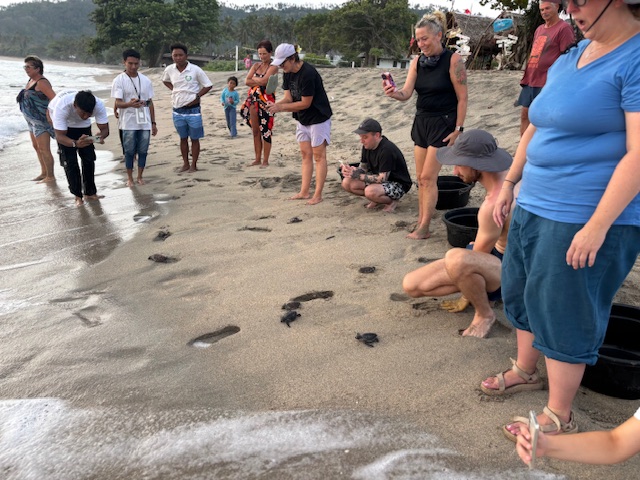
Some of us cheer as the determined turtles draw closer to the sea. Most of us snap photos or shoot video with our cell phones. We’re all volunteers, mostly from England and Germany, in Green Lion’s ongoing sea turtle conservation project, which began in July 2024.
Like a worried parent, I’m concerned about how or if these little ones will survive once they’re immersed in the deep. It seems hard to believe that their limbs will last against the forceful crash of waves.
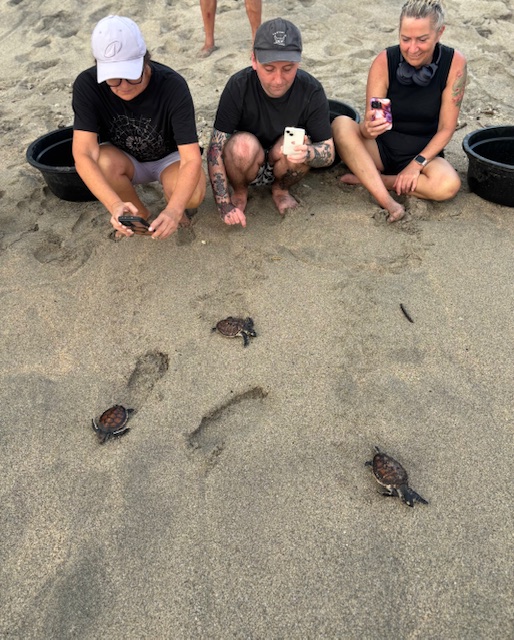
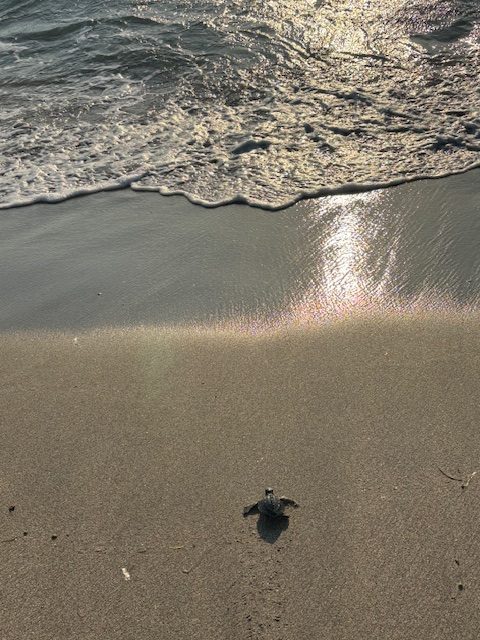
Sea turtle protection laws not enforced in Indonesia
The three marine turtle species released that afternoon are the lucky ones that have avoided predation and other fates. Overall, their species have faced poor survival odds in the Indian Ocean, based on their regional scientific status: hawksbill turtle (critically endangered), green turtle (endangered, although recently downgraded globally to “least concern”), and Olive Ridley (vulnerable).
That’s why the Lombok conservation project is vital to help these three species fulfill what has been their normal life span of 50 to 100 years. Lately, the survival rate of sea turtles in Indonesia is only about one to two per cent, says Andre, but he adds that the Green Lion program is boosting that to between 50 and 70 per cent. (Although they have not yet implemented a system to tag the turtles, plans for that are in the works, says program co-ordinator Efan Pantur.)
To access sea turtles for the program, the coordinators either collect hatchlings themselves or buy eggs from local fishermen. They pay 250,000-300,000 rupiahs (about $17-$25 CDN) for about 170 eggs, says Andre. Otherwise, these eggs would get sold as food at local markets.
Even though sea turtles in Indonesia are legally protected, there is little enforcement. “In the last 20 years, there has been a low sea turtle population and Green Lion plans to get this higher again,” says Efan.
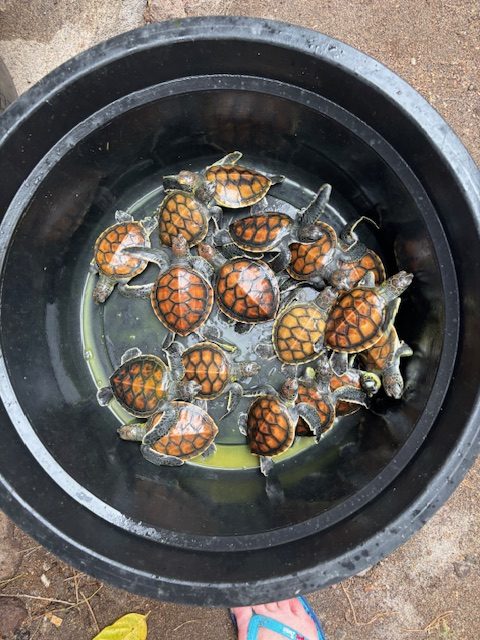
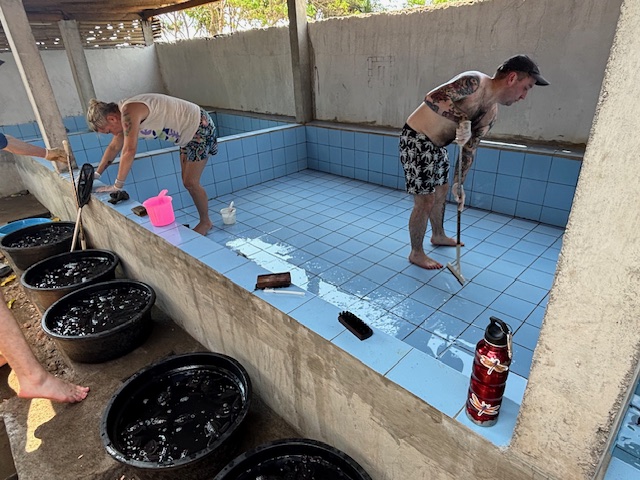
Vet visits and daily cleaning increase survival rate of program’s sea turtles
Five days a week, as volunteers, we donned latex gloves and scrubbed the project’s tanks and refilled them with water. With toothbrushes, we gently cleaned the turtles of bacteria and food waste, then applied iodine drops to any of their wounds like an infected eye or chewed flipper. We fed them mashed-up, thawed tuna and sometimes, tiny beach crabs we caught on Landang Luar Beach, north of touristy Senggigi Beach. Some volunteers worked on constructing new tanks or maintaining existing ones.
During my two-week stint (volunteers can stay from a week to several months), it was heartening to see that some injured turtles, mostly kept in separate tanks, had healed from iodine applications and hence, we could relocate them to the tanks full of healthy turtles. That put them closer to freedom. “They want to get out,” says Andre. “The tank is like a prison to them.”
Twice a month, an Indonesian veterinarian from Bali visits the tanks, checks the turtles and provides treatment to any injuries, says Efan. The vet has told him that the project needs more tanks to keep the young turtles less stressed in captivity. Sometimes, they have had up to 2,000 sea turtles at once, says Andre. “We do the best we can.” Construction of more tanks is underway.
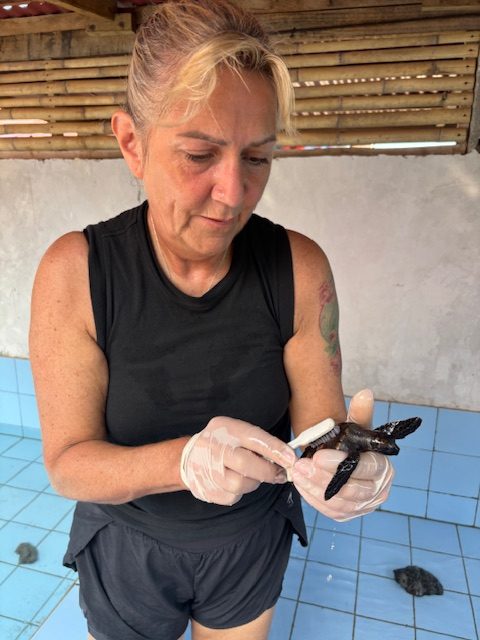
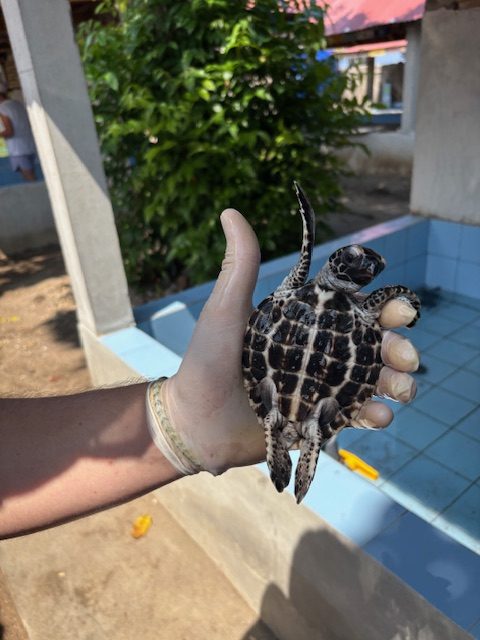
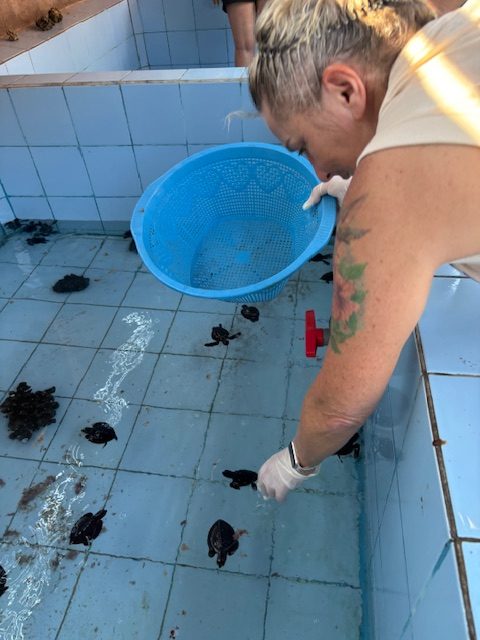
Habitat loss and climate change threaten sea turtle survival
Like the planet’s four other endangered sea turtle species, Lombok’s three local species face the loss and degradation of their natural habitats due to plastic and human debris, rising sea levels, increased flooding, severe storms and beachfront development. Harvesting of their eggs and meat, skin, and shells for food plus their accidental capture and/or death by gillnets and other fishing gear have also shrunk their numbers locally and around the world.
The waters around Indonesia, where the Pacific and Indian Oceans meet, are an important migration route for sea turtles. Yet, we can’t ignore the impact of exploitative tourism and climate change. Both factors threaten coral reefs, which help provide breeding and feeding grounds for sea turtles.
By the Gili Islands off Lombok, while snorkelling to view sea turtles underwater – a guaranteed sight, promised our guiding operator – I was horrified to see a lot of dead and dying coral reefs. Amidst the delight of spotting three turtles in separate places, I felt sickened to see so many bleak white moonscapes amidst the brilliant flash of schools of neon and multi-coloured fish.
(Tourists: Please avoid touching any coral and sea turtles and give them space. During my boat tour, the guide pleaded with 20 of us not to touch the turtles, yet one guy in our group did anyway. Choose a sunscreen that’s safe for both coral reefs and sea turtles. Check the active ingredients and avoid products with oxybenzone and octinoxate. Use one that contains only mineral UV-blocking ingredients such as oxide and titanium dioxide.)
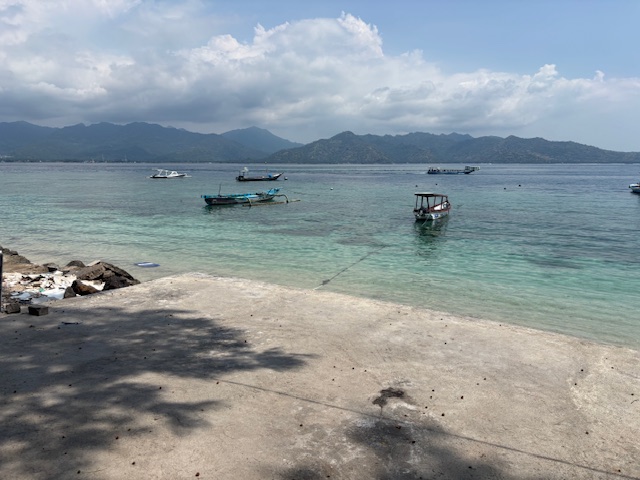

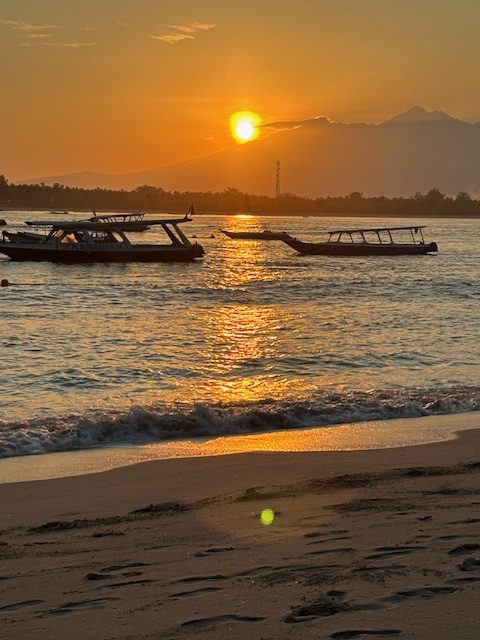
Meanwhile, on shore, lights from hotels, stores, roads and houses are posing dangers to sea turtles everywhere. Hatchlings usually break out of their eggs at night and head towards the brightest light they see, which should be the moon over the ocean. The baby turtles follow its glow to make it safely to the sea. But today, street lights, neon signs and other bright lights can confuse them, causing them to crawl in the wrong direction. As a result, hatchlings can become too tired, weak or lost to reach the ocean, or else get hit by a car.
Globally, environmental warming and temperature fluctuations, influenced by climate change, threaten sea turtle populations. These impacts not only change the gender of sea turtles but can even kill some eggs from extreme heat. Normally, the temperature of developing eggs determines gender. If the eggs stay cool enough (below 27.7C or 81.86F), they’ll produce males. However, warmer sand, at higher temperatures, will produce female hatchlings. Currently, around 99 per cent of sea turtles are born female, which drastically lessens the chances of successful fertilization and continuation of a healthy species.

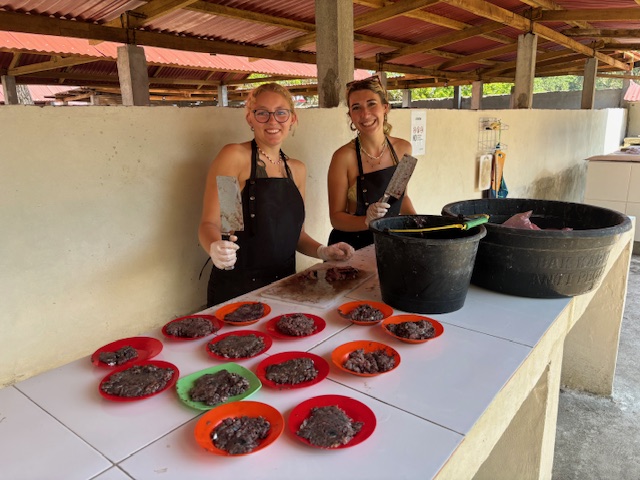
New laws, National Action Plan and banned plastic provide hope
Yet, there is hope. The Indonesian government is collaborating with different organizations to draft the 2025-2029 National Action Plan for the Conservation of Sea Turtles and Cetaceans. Their goal is to develop guidelines to lessen the impact of human activities on these two groups of ocean-dwellers.
Bali was once a major centre for the illegal sea turtle trade but the country officially shut this down in 2002. Starting in February 2025, the island banned plastic water bottles of one litre or less in size. A few months later, Bali made it illegal for businesses to provide single-use plastics such as straws, bags, Styrofoam and plastic-packaged drinks.
Sadly, the island of Lombok has no such law – so far, anyway. Styrofoam bits and swathes of plastic debris are visible on its numerous beaches, in the jungles, and elsewhere. While on Landang Luar Beach we did beach clean-ups. In less than a half-hour, we filled several large tubs with beach garbage, from cigarette butts and empty packs to Styrofoam and used cups.
The dive centre Oceans 5, on Gili Air, one of three Gili islands off Lombok, has conducted weekly beach clean-ups for 15 years. It includes conservation as a core part of its diving philosophy.
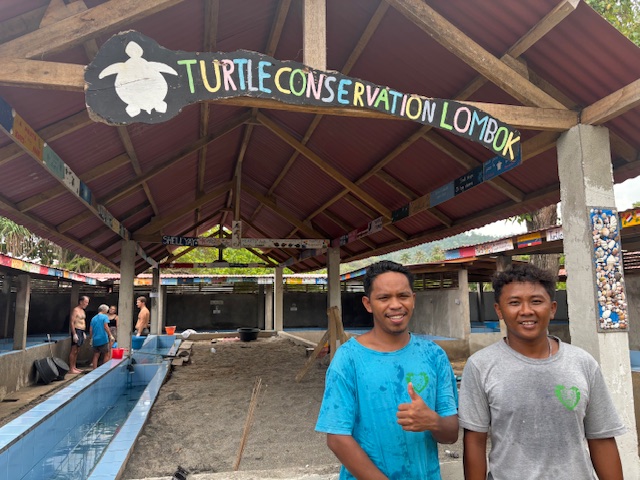
Above: Co-coordinators of the Lombok Sea Turtle Conservation Project Efan Pantur (left) and Andre Andrianto. Right: The author (left) with Green Lion staff and volunteers Ben (second from right) and Laura (third from right).

CLICK HERE TO SEE A FUN, 1.27-MINUTE VIDEO OF THE LOMBOK SEA TURTLE CONSERVATION PROGRAM, MADE BY GREEN LION. LIKE THE END OF THE VIDEO SAYS: “LET’S PROTECT OUR OCEANS, SAVE THE TURTLES, AND CREATE A BETTER FUTURE FOR THE NEXT GENERATION.”
This post is the first in a two-part series. Part two coming soon: “More funds needed to maintain and expand sea turtle conservation project.”
Note: Green Lion receives no government funding for its sea turtle conservation program and relies wholly on volunteer donations. To donate, please see the GoFundMe campaign Fundraiser by Heather Conn : Lombok Sea Turtle Project.
To find out more about volunteering for the Lombok project through International Volunteer HQ, see Turtle Conservation Project in Lombok | IVHQ.
Sources:
Andrianto, Andre. In-person interview. Lombok. Sept. 30, 2025.
Bali Bans Plastic Bottles: A Major Step Towards Sustainability. Accessed Oct. 24, 2025.
Bali to Ban Plastic Water Bottles of Less than One Liter Capacity | Bali Discovery. Accessed Oct. 24, 2025
BeachSearcher. “Lendang Luar Beach.” Lendang Luar Beach Dusun Setangi, Lombok island, Indonesia – detailed features, map, photos. Accessed Oct. 24, 2025
Comply or Shut Down: What to Know About Bali’s New Waste Management Rules – The Bali Media. Accessed Oct. 24, 2025.
Green sea turtles no longer endangered as global population rebounds: NPR. Accessed Oct. 24, 2025.
Indian Ocean Tuna Commission. “Status of marine turtles in the Indian Ocean.” IOTC-2019-SC22-ES24_-_Marine_Turtles_E.pdf. Accessed Oct. 24, 2025.
National Ocean Service. National Oceanic and Atmospheric Administration. What causes a sea turtle to be born male or female?. Accessed Oct. 29, 2025.
PADI IDC Dive Resort in Indonesia. Weekly Beach Cleanups at Oceans 5 Gili Air: A 15-Year Commitment to Conservation and Community | PADI IDC Dive Resort in Indonesia. Accessed Nov. 6, 2025.
Pantur, Efan. In-person interview. Lombok. Sept. 30, 2025.
The State of Sea Turtles in the East Indian Ocean and Southeast Asia — The State of the World’s Sea Turtles | SWOT. Accessed Oct. 24, 2025.
SWOT+Report+19_Final.pdf. Accessed Oct. 24, 2025.
Thomson, Sarah L. Save the Turtles. Philomel, 2024.
World Wildlife Fund. How Long Do Sea Turtles Live? | World Wildlife Fund. Accessed Oct. 29, 2025.
World Wildlife Fund. Indonesia. INDONESIA’S MIGRATORY SEA TURTLES NEED OUR PROTECTION. Accessed Oct. 29, 2025.
